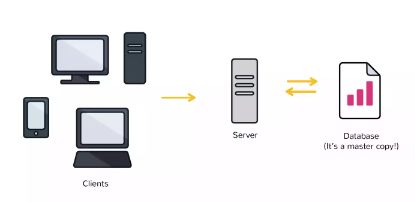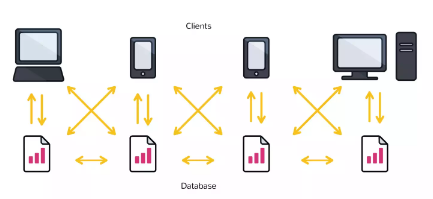From a cruising altitude, a blockchain might not look that different from things you're familiar with, say Wikipedia.
With a blockchain, many people can write entries into a record of information, and a community of users can control how the record of information is amended and updated. Likewise, Wikipedia entries are not the product of a single publisher. No one person controls the information.
Descending to ground level, however, the differences that make blockchain technology unique become more clear. While both run on distributed networks (the internet), Wikipedia is built into the World Wide Web (WWW) using a client-server network model.
A user (client) with permissions associated with its account is able to change Wikipedia entries stored on a centralized server.
Whenever a user accesses the Wikipedia page, they will get the updated version of the 'master copy' of the Wikipedia entry. Control of the database remains with Wikipedia administrators allowing for access and permissions to be maintained by a central authority. 
Wikipedia's digital backbone is similar to the highly protected and centralized databases that governments or banks or insurance companies keep today. Control of centralized databases rests with their owners, including the management of updates, access and protecting against cyber-threats.
The distributed database created by blockchain technology has a fundamentally different digital backbone. This is also the most distinct and important feature of blockchain technology.
Wikipedia's 'master copy' is edited on a server and all users see the new version. In the case of a blockchain, every node in the network is coming to the same conclusion, each updating the record independently, with the most popular record becoming the de-facto official record in lieu of there being a master copy. ! 
Transactions are broadcast, and every node is creating their own updated version of events.
It is this difference that makes blockchain technology so useful – It represents an innovation in information registration and distribution that eliminates the need for a trusted party to facilitate digital relationships.
Yet, blockchain technology, for all its merits, is not a new technology.
Rather, it is a combination of proven technologies applied in a new way. It was the particular orchestration of three technologies (the Internet, private key cryptography and a protocol governing incentivization) that made bitcoin creator Satoshi Nakamoto's idea so useful. 
The result is a system for digital interactions that does not need a trusted third party. The work of securing digital relationships is implicit — supplied by the elegant, simple, yet robust network architecture of blockchain technology itself.
Defining digital trust
Trust is a risk judgement between different parties, and in the digital world, determining trust often boils down to proving identity (authentication) and proving permissions (authorization).
Put more simply, we want to know, 'Are you who you say you are?' and 'Should you be able to do what you are trying to do?'
In the case of blockchain technology, private key cryptography provides a powerful ownership tool that fulfills authentication requirements. Possession of a private key is ownership. It also spares a person from having to share more personal information than they would need to for an exchange, leaving them exposed to hackers.
Authentication is not enough. Authorization – having enough money, broadcasting the correct transaction type, etc – needs a distributed, peer-to-peer network as a starting point. A distributed network reduces the risk of centralized corruption or failure.
This distributed network must also be committed to the transaction network’s recordkeeping and security. Authorizing transactions is a result of the entire network applying the rules upon which it was designed (the blockchain’s protocol).
Authentication and authorization supplied in this way allow for interactions in the digital world without relying on (expensive) trust. Today, entrepreneurs in industries around the world have woken up to the implications of this development – unimagined, new and powerful digital relationshionships are possible. Blockchain technology is often described as the backbone for a transaction layer for the Internet, the foundation of the Internet of Value.
In fact, the idea that cryptographic keys and shared ledgers can incentivize users to secure and formalize digital relationships has imaginations running wild. Everyone from governments to IT firms to banks is seeking to build this transaction layer.
Authentication and authorization, vital to digital transactions, are established as a result of the configuration of blockchain technology.
The idea can be applied to any need for a trustworthy system of record.
Authored by Nolan Bauerle; images by Maria Kuznetsov
Hi! I am a robot. I just upvoted you! I found similar content that readers might be interested in:
http://www.coindesk.com/information/what-is-blockchain-technology/
Downvoting a post can decrease pending rewards and make it less visible. Common reasons:
Submit
Nice bro
Downvoting a post can decrease pending rewards and make it less visible. Common reasons:
Submit